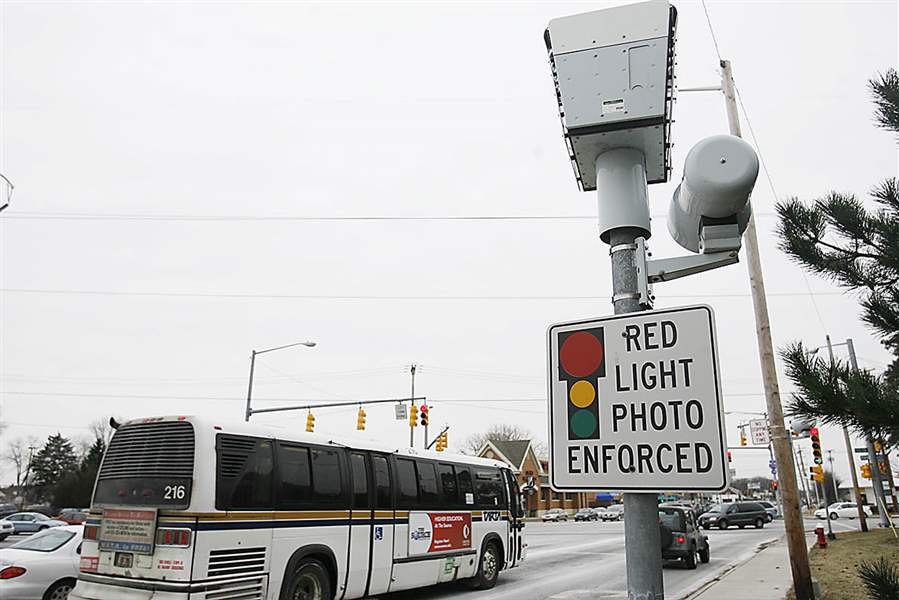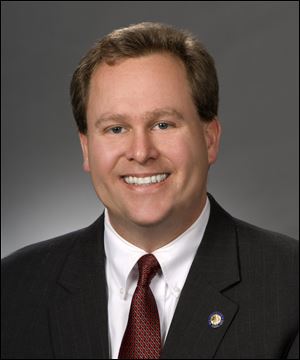
EDITORIAL
Control traffic cameras
11/18/2013
Toledo has 43 red-light and speed-enforcement cameras.
THE BLADE
Buy This Image

Toledo has 43 red-light and speed-enforcement cameras.
A bill working its way through the Ohio General Assembly would prohibit red-light and speed-enforcement cameras in the state and limit the use of speed cameras to 20 mph school zones.

Bacon
Toledo, which introduced the cameras in 2001, now has 43 fixed cameras and one mobile speed van with a camera that operates in school zones.
Rather than outlaw what has shown to save lives and reduce accidents, the legislature should move on a proposal from Sen. Kevin Bacon (R., Columbus) who wants to establish statewide standards for the cameras’ operation.
None exists now to prevent abuses such as those uncovered in Elmwood Place in southwest Ohio.
Cameras there turned the village of 2,200, nearly surrounded by the city of Cincinnati, into a virtual speed trap, where the number of speeding tickets skyrocketed immediately after cameras were installed.
An angry judge shut down the operation earlier this year.
In June, the Ohio House voted 64-32 in favor of the camera-banning House Bill 69. It is now before a Senate committee on which Mr. Bacon sits.
Mr. Bacon wants to have police officers approve each civil citation, require safety studies of intersections before cameras are installed, and ensure that drivers are able to challenge a citation.
Representatives of Toledo and other municipalities that use the cameras supported adopting standards in Columbus last week.
Toledo Police Lieutenant Jeff Sulewski, commander of the traffic section and project manager for photo enforcement, says the city has seen a “drastic decrease” in the number of tickets issued at the camera locations. That suggests the program is working.
The Insurance Institute for Highway Safety in Washington cites two studies — one international, one in the United States — that show red light cameras save lives and reduce serious accidents.
A study of the cameras in large U.S. cities found they reduced fatal red-light-running crash rates by 24 percent and rates of all fatal crashes at intersections with signals by 17 percent.
The Toledo statistics cited in the study showed the number of fatal crash rates declined.
Some but not all studies found an increase in rear-enders, but the federal government found that the increase was more than offset by a big reduction in more serious right-angle or T-Bone crashes.
Not surprisingly, the cameras are unpopular.
Several weeks ago on the Anthony Wayne Trail, a man standing near the speed camera held a homemade sign reading “Honk if you hate cameras.” That location just north of the Toledo Zoo is the only one to have only speed cameras without an accompanying red-light camera.
But Mr. Sulewski said cameras were installed there after neighbors complained that the road had turned into a drag strip.
They worked, he said. During a covert test on the Trail, a camera recorded 2,000 violations in one day. After the camera was officially installed in September, 2012, a total of 1,500 tickets were issued over the next four months, he said.
He said authorities determine where to place cameras based on the number of accidents, complaints about unsafe driving, and officer reports.
Opponents of traffic cameras say the devices are used more to generate revenue for localities and the camera companies that supply them. Still, Toledo’s proposed 2014 budget anticipates generating $1 million less from such cameras — down to $3.2 million next year.
Opponents might argue that drivers are finding ways to avoid getting caught, but it’s more likely that safer driving is lowering the number of tickets and reducing revenue.
Red-light cameras make roads safer, but municipalities shouldn’t regard them as ATM machines. Uniform statewide guidelines are needed to protect drivers from abuses and hyper-enforcement.